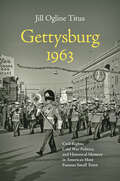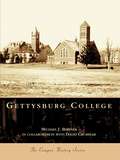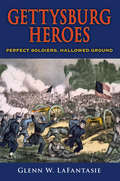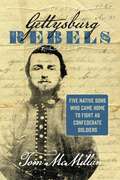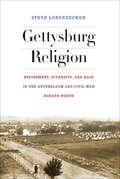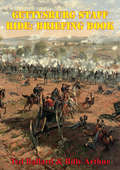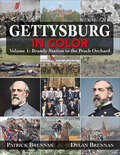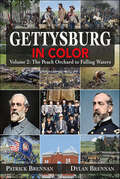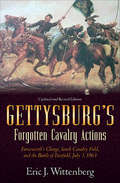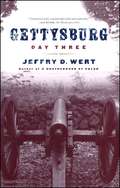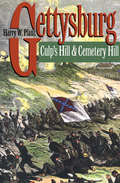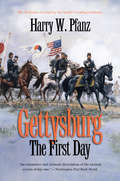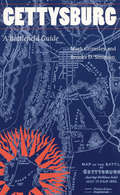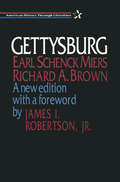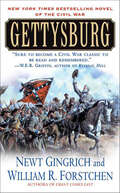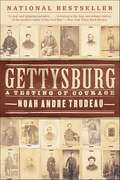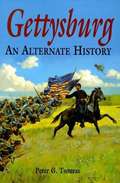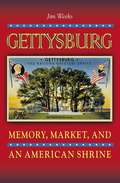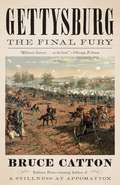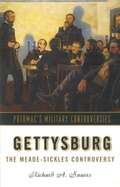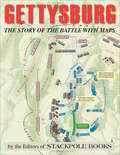- Table View
- List View
Gettysburg 1963: Civil Rights, Cold War Politics, and Historical Memory in America's Most Famous Small Town (Civil War America)
by Jill Ogline TitusThe year 1963 was unforgettable for Americans. In the midst of intense Cold War turmoil and the escalating struggle for Black freedom, the United States also engaged in a nationwide commemoration of the 100th anniversary of the Civil War. Commemorative events centered on Gettysburg, site of the best-known, bloodiest, and most symbolically charged battle of the conflict. Inevitably, the centennial of Lincoln's iconic Gettysburg Address received special focus, pressed into service to help the nation understand its present and define its future--a future that would ironically include another tragic event days later with the assassination of another American president. In this fascinating work, Jill Ogline Titus uses centennial events in Gettysburg to examine the history of political, social, and community change in 1960s America. Examining the experiences of political leaders, civil rights activists, preservation-minded Civil War enthusiasts, and local residents, Titus shows how the era's deep divisions thrust Gettysburg into the national spotlight and ensured that white and Black Americans would define the meaning of the battle, the address, and the war in dramatically different ways.
Gettysburg College
by Michael J. Birkner David CrumplarGettysburg College is the oldest Lutheran affiliated college in the United States. At its founding in 1832--a time of social ferment and advancing democracy--college leaders emphasized a liberal arts mission. Pennsylvania College, as it was known until 1919, numbers among its graduates many clergy, lawyers, and physicians, as well as politicians, social gospel advocates, scientists, business executives, and university presidents. Although the college has grown considerably since World War II, its mission has remained consistent: devotion to the pursuit of truth and active citizenship. Through historic photographs, Gettysburg College documents significant themes in the college's history: an expanding campus, the emergence and influence of intercollegiate athletic teams and social fraternities, curricular change, and key national events that affected the college, none of the latter more important than the Battle of Gettysburg and two world wars. Always respected for its academic program, Gettysburg College has in the past generation diversified its faculty and student body, expanded its interdisciplinary programs, and gained in reputation as a leading national liberal arts college.
Gettysburg Heroes
by Glenn W. LafantasieThe Civil War generation saw its world in ways startlingly different from our own. In these essays, Glenn W. LaFantasie examines the lives and experiences of several key personalities who gained fame during the war and after. The battle of Gettysburg is the thread that ties these Civil War lives together. Gettysburg was a personal turning point, though each person was affected differently. Largely biographical in its approach, the book captures the human drama of the war and shows how this group of individuals--including Abraham Lincoln, James Longstreet, Joshua Lawrence Chamberlain, William C. Oates, and others--endured or succumbed to the war and, willingly or unwillingly, influenced its outcome. At the same time, it shows how the war shaped the lives of these individuals, putting them through ordeals they never dreamed they would face or survive.
Gettysburg National Military Park (Images of Modern America)
by Jared Frederick Christopher GwinnThe picturesque Gettysburg Battlefield has long been memorialized as an iconic landscape of America's national identity. The tumultuous Civil War battle and Abraham Lincoln's subsequent address transformed the country in profound ways that continue to echo throughout the ages. In the aftermath of the struggle, Gettysburg National Military Park was embraced by citizens not only as a shrine of commemoration but also as a public space utilized for leisure, education, politics, and discovery. This compelling photographic history documents the park from the post-World War II era onward, chronicling the dramatic evolutions the battlefield has undergone in the wake of modern tourism. Exploring the fascinating issues of historical memory, preservation, and popular culture, the book paints a vivid picture of a national park at work for the benefit "of the people."
Gettysburg Rebels: Five Native Sons Who Came Home to Fight as Confederate Soldiers
by Tom McmillanGettysburg Rebels is the gripping true story of five young men who grew up in Gettysburg, moved south to Virginia in the 1850s, joined the Confederate army - and returned "home" as foreign invaders for the great battle in July 1863. Drawing on rarely-seen documents and family histories, as well as military service records and contemporary accounts, Tom McMillan delves into the backgrounds of Wesley Culp, Henry Wentz and the three Hoffman brothers in a riveting tale of Civil War drama and intrigue.
Gettysburg Religion: Refinement, Diversity, and Race in the Antebellum and Civil War Border North (The North's Civil War)
by Steve LongeneckerIn the borderland between freedom and slavery, Gettysburg remains among the most legendary Civil War landmarks. A century and a half after the great battle, Cemetery Hill, the Seminary and its ridge, and the Peach Orchard remain powerful memories for their embodiment of the small-town North and their ability to touch themes vital to nineteenth-century religion. During this period, three patterns became particularly prominent: refinement, diversity, and war. In Gettysburg Religion, author Steve Longenecker explores the religious history of antebellum and Civil War–era Gettysburg, shedding light on the remarkable diversity of American religion and the intricate ways it interacted with the broader culture. Longenecker argues that Gettysburg religion revealed much about larger American society and about how trends in the Border North mirrored national developments. In many ways, Gettysburg and its surrounding Border North religion belonged to the future and signaled a coming pattern for modern America.
Gettysburg Staff Ride: Briefing Book [Illustrated Edition]
by Ted Ballard Billy ArthurContains more than 20 maps, diagrams and illustrationsIf neither General Meade nor General Lee planned to fight at Gettysburg, how did it happen that the first three days of July 1863 were to become arguably the most important span in the Civil War? That question cannot be fully answered without viewing McPherson's Ridge or Oak Hill, nor can one really understand the urgency of Chamberlain's bayonet charge nor the audacity of Pickett's division at the Angle without visiting those places.Accordingly, the purpose of a Gettysburg staff ride is to visit these and other locations on the battlefield and analyze the battle through the eyes of the men who were there, both leaders and rank and file soldiers. Hopefully, by understanding the actions, inactions and reactions of commanders and their troops in real situations we may gain insights into the human condition under stress and decision making during combat.
Gettysburg in Color: Volume 1: Brandy Station to the Peach Orchard
by Dylan Brennan Patrick BrennanArtificial Intelligence meets Gettysburg. And it is a marvelous pairing. Patrick Brennan, a long-time student of the Civil War, published author, and an editorial advisor for The Civil War Monitor magazine, has teamed up with his technology-astute daughter Dylan Brennan to bring the largest Civil War battle to life in the remarkable 2-volume study: Gettysburg in Color. Volume 1 covers Brandy Station to the Peach Orchard, and Volume 2 covers The Wheatfield to Falling Waters. Rather than guess or dabble with the colors, the Brennans used an artificial intelligence-based computerized color identifier to determine the precise color of uniforms, flesh, hair, equipment, terrain, houses, and much more. The result is a monumental full-color study of the important three-day battle that brings the men, the landscape, and the action into the 21st Century. The deep colorization of battle-related woodcuts, for example, reveals a plethora of details that have passed generations of eyes unseen. The photos of the soldiers and their officers look as if they were taken yesterday. The use of this modern technology shines a light on one Gettysburg photographic mystery in particular. Colorizing some of the battle’s “death” images revealed the presence of Union and Confederate dead that may help determine the previously unknown location of the photographs. That may also be a “first” when it comes to Civil War photography, as Pat Brennan explains: “It was long believed this was an image of seven dead Union soldiers. In fact, only five are Union men. The other two are Confederates. I am still researching the issue, but I believe this may be the only photo we have from the entire Civil War that portrays dead from both sides.” In the early 1960s, the unique presentation in Bruce Catton’s The American Heritage Picture History of the Civil War spurred the interest of a generation of readers. With its sweeping prose and stunning visuals, Gettysburg in Color will have a similar impact on future generations as it takes its place as one of the most influential titles on the American Civil War.
Gettysburg in Color: Volume 2: The Wheatfield to Falling Waters
by Dylan Brennan Patrick BrennanArtificial Intelligence meets Gettysburg. And it is a marvelous pairing. Patrick Brennan, a long-time student of the Civil War, published author, and an editorial advisor for The Civil War Monitor magazine, has teamed up with his technology-astute daughter Dylan Brennan to bring the largest Civil War battle to life in the remarkable 2-volume study: Gettysburg in Color. Volume 1 covers Brandy Station to the Peach Orchard, and Volume 2 covers The Wheatfield to Falling Waters. Rather than guess or dabble with the colors, the Brennans used an artificial intelligence-based computerized color identifier to determine the precise color of uniforms, flesh, hair, equipment, terrain, houses, and much more. The result is a monumental full-color study of the important three-day battle that brings the men, the landscape, and the action into the 21st Century. The deep colorization of battle-related woodcuts, for example, reveals a plethora of details that have passed generations of eyes unseen. The photos of the soldiers and their officers look as if they were taken yesterday. The use of this modern technology shines a light on one Gettysburg photographic mystery in particular. Colorizing some of the battle’s “death” images revealed the presence of Union and Confederate dead that may help determine the previously unknown location of the photographs. That may also be a “first” when it comes to Civil War photography, as Pat Brennan explains: “It was long believed this was an image of seven dead Union soldiers. In fact, only five are Union men. The other two are Confederates. I am still researching the issue, but I believe this may be the only photo we have from the entire Civil War that portrays dead from both sides.” In the early 1960s, the unique presentation in Bruce Catton’s The American Heritage Picture History of the Civil War spurred the interest of a generation of readers. With its sweeping prose and stunning visuals, Gettysburg in Color will have a similar impact on future generations as it takes its place as one of the most influential titles on the American Civil War.
Gettysburg's Forgotten Cavalry Actions: Farnsworths Charge, South Cavalry Field, and the Battle of Fairfield, July 3, 1863
by Eric J. WittenbergAn award-winning historical study of the important role played by Union and Confederate horse soldiers on the Civil War battlefield at Gettysburg. The Union army&’s victory at Gettysburg, Pennsylvania, on July 3, 1863, is widely considered to have been the turning point in America&’s War between the States. But the valuable contributions of the mounted troops, both Northern and Rebel, in the decisive three-day conflict have gone largely unrecognized. Acclaimed Civil War historian Eric J. Wittenberg now gives the cavalries their proper due. In Gettysburg&’s Forgotten Cavalry Actions, Wittenberg explores three important mounted engagements undertaken during the battle and how they influenced the final outcome. The courageous but doomed response by Brig. Gen. Elon J. Farnsworth&’s cavalry brigade in the wake of Pickett&’s Charge is recreated in fascinating detail, revealing the fatal flaws in the general&’s plan to lead his riders against entrenched Confederate infantry and artillery. The tenacious assault led by Brig. Gen. Wesley Merritt on South Cavalry Field is also examined, as is the strategic victory at Fairfield by Southern troops that nearly destroyed the Sixth US Cavalry and left Hagerstown Road open, enabling General Lee&’s eventual retreat. Winner of the prestigious Bachelder-Coddington Award for historical works concerning the Battle of Gettysburg, Eric J. Wittenberg&’s Gettysburg&’s Forgotten Cavalry Actions rights a long-standing wrong by lifting these all-important engagements out of obscurity. A must-read for Civil War buffs everywhere, it completes the story of the battle that changed American history forever.
Gettysburg, Day Three
by Jeffry D. WertJeffry D. Wert re-creates the last day of the bloody Battle of Gettysburg in astonishing detail, taking readers from Meade's council of war to the seven-hour struggle for Culp's Hill -- the most sustained combat of the entire engagement. Drawing on hundreds of sources, including more than 400 manuscript collections, he offers brief excerpts from the letters and diaries of soldiers. He also introduces heroes on both sides of the conflict -- among them General George Greene, the oldest general on the battlefield, who led the Union troops at Culp's Hill.A gripping narrative written in a fresh and lively style, Gettysburg, Day Three is an unforgettable rendering of an immortal day in our country's history.
Gettysburg--Culp's Hill and Cemetery Hill
by Harry W. PfanzIn this companion to his celebrated earlier book, Gettysburg--The Second Day, Harry Pfanz provides the first definitive account of the fighting between the Army of the Potomac and Robert E. Lee's Army of Northern Virginia at Cemetery Hill and Culp's Hill--two of the most critical engagements fought at Gettysburg on 2 and 3 July 1863. Pfanz provides detailed tactical accounts of each stage of the contest and explores the interactions between--and decisions made by--generals on both sides. In particular, he illuminates Confederate lieutenant general Richard S. Ewell's controversial decision not to attack Cemetery Hill after the initial southern victory on 1 July. Pfanz also explores other salient features of the fighting, including the Confederate occupation of the town of Gettysburg, the skirmishing in the south end of town and in front of the hills, the use of breastworks on Culp's Hill, and the small but decisive fight between Union cavalry and the Stonewall Brigade."Rich with astute judgments about officers on each side, clearly written, and graced with excellent maps, Pfanz's book is tactical history at its finest.--Civil War "A meticulous examination of the desperate engagements that over the course of the three days swept up and down the rough slopes of these two hills, the strategic anchors of the Union right flank.--New York Times Book Review"The first and most comprehensive narrative yet written on this part of the battlefield. . . . Civil War enthusiasts should clear a space on their bookshelf for Gettysburg--Culp's Hill and Cemetery Hill.--Blue and Gray Harry Pfanz provides the definitive account of the fighting between the Army of the Potomac and Robert E. Lee's Army of Northern Virginia at Cemetery Hill and Culp's Hill--two of the most critical engagements fought at Gettysburg on 2 and 3 July 1863. He provides detailed tactical accounts of each stage of the contest and explores the interactions between--and decisions made by--generals on both sides. In particular, he illuminates Confederate lieutenant general Richard S. Ewell's controversial decision not to attack Cemetery Hill after the initial Southern victory on 1 July. -->
Gettysburg--The First Day
by Harry W. PfanzFor good reason, the second and third days of the Battle of Gettysburg have received the lion's share of attention from historians. With this book, however, the critical first day's fighting finally receives its due. After sketching the background of the Gettysburg campaign and recounting the events immediately preceding the battle, Harry Pfanz offers a detailed tactical description of events of the first day. He describes the engagements in McPherson Woods, at the Railroad Cuts, on Oak Ridge, on Seminary Ridge, and at Blocher's Knoll, as well as the retreat of Union forces through Gettysburg and the Federal rally on Cemetery Hill. Throughout, he draws on deep research in published and archival sources to challenge many long-held assumptions about the battle.
Gettysburg--The Second Day
by Harry W. PfanzThe second day's fighting at Gettysburg--the assault of the Army of Northern Virginia against the Army of the Potomac on 2 July 1863--was probably the critical engagement of that decisive battle and, therefore, among the most significant actions of the Civil War. Harry Pfanz, a former historian at Gettysburg National Military Park, has written a definitive account of the second day's brutal combat. He begins by introducing the men and units that were to do battle, analyzing the strategic intentions of Lee and Meade as commanders of the opposing armies, and describing the concentration of forces in the area around Gettysburg. He then examines the development of tactical plans and the deployment of troops for the approaching battle. But the emphasis is on the fighting itself. Pfanz provides a thorough account of the Confederates' smashing assaults -- at Devil's Den and Litle Round Top, through the Wheatfield and the Peach Orchard, and against the Union center at Cemetery Ridge. He also details the Union defense that eventually succeeded in beating back these assaults, depriving Lee's gallant army of victory.Pfanz analyzes decisions and events that have sparked debate for more than a century. In particular he discusses factors underlying the Meade-Sickles controversy and the questions about Longstreet's delay in attacking the Union left. The narrative is also enhanced by thirteen superb maps, more than eighty illustrations, brief portraits of the leading commanders, and observations on artillery, weapons, and tactics that will be of help even to knowledgeable readers. Gettysburg--The Second Day is certain to become a Civil War classic. What makes the work so authoritative is Pfanz' mastery of the Gettysburg literature and his unparalleled knowledge of the ground on which the fighting occurred. His sources include the Official Records, regimental histories and personal reminiscences from soldiers North and South, personal papers and diaries, newspaper files, and last -- but assuredly not least -- the Gettysburg battlefield. Pfanz's career in the National Park Service included a ten-year assignment as a park historian at Gettysburg. Without doubt, he knows the terrain of the battle as well as he knows the battle itself.
Gettysburg: A Battlefield Guide (This Hallowed Ground: Guides to Civil War Battlefields)
by Brooks D. Simpson Mark GrimsleyLittle Round Top, the Railroad Cut, Pickett’s Charge—these are the turning points within the most important battle of the Civil War. Even careful students of Gettysburg, however, can find themselves disoriented when visiting the site itself. Here, finally, is a convenient guide for serious student and casual visitor alike that makes plain the sweep of events and the geography of the battlefield. This invaluable guidebook was created by scholars who have walked the battlegrounds, consulted with local experts and park guides, and studied the testimony left behind by the participants. Gettysburg will help you find all the important locales and understand what the participants saw in 1863, even if you have no prior knowledge of the battle. Designed to enhance the experience of both first-time and returning visitors, this guide can be used alone or as a supplement to a tour. Clearly written and illustrated with maps and photographs, this is the book to have when you explore Gettysburg.
Gettysburg: A New Edition With A Foreword By James I. Robertson, Jr (Civil War Paintings Ser. #2)
by Richard A. Brown Earl Schenck Miers James L. Robertson JrOriginally published in 1948, this book tells the story of the three fateful days of Gettysburg in the words of the men and women who lived it. No mere chronicle of troop movements and military decisions, it is a path-breaking work in the reporting of Civil War history. Praised by "The New York Times Book Review" as "the very best collection of firsthand accounts, written by soldiers and civilians" of the battle of Gettysburg, this volume has been out of print for many years. Edited by Earl Schenk Miers (1910-1972), one of the pioneers in reviving popular interest in the American Civil War and in Lincoln, this new edition is enriched with a foreword by noted Civil War scholar James I. Robertson, Jr. For many years a favourite among Civil War buffs and enthusiasts, this edition is ideally suited for use in American history courses on the Civil War and military history and in American history survey courses.
Gettysburg: A Novel of the Civil War (The Gettysburg Trilogy #1)
by Newt Gingrich William R. ForstchenThe New York Times–bestselling Civil War novel: a “well-executed alternative history [that] imagines a Confederate victory at Gettysburg” (Publishes Weekly).An action-packed and painstakingly researched novel by former Speaker of the House Newt Gingrich and historical fiction author William R. Forstchen, Gettysburg stands as the first book in a series to tell the story of how a victory for Confederate General Robert E. Lee would have changed the destiny of the nation forever.The year is 1863, and General Lee and his Army of Northern Virginia are poised to attack the North. Launching his men into a sweeping operation, Lee audaciously pursues his last best chance for ultimate victory. With renewed spirit, Lee’s lieutenants embark on the Gettysburg Campaign that many dream “should have been.”The soldiers in the line, Yank and Reb, knew as well that this would be the great challenge, the decisive moment that would decide whether a nation would die, or be created. Both sides were ready, willing to lay down their lives for their Cause.
Gettysburg: A Testing of Courage
by Noah Andre TrudeauAmerica's Civil War raged for more than four years, but it is the three days of fighting in the Pennsylvania countryside in July 1863 that continues to fascinate, appall, and inspire new generations with its unparalleled saga of sacrifice and courage. From Chancellorsville, where General Robert E. Lee launched his high-risk campaign into the North, to the Confederates' last daring and ultimately-doomed act, forever known as Pickett's Charge, the battle of Gettysburg gave the Union army a victory that turned back the boldest and perhaps greatest chance for a Southern nation.Now acclaimed historian Noah Andre Trudeau brings the most up-to-date research available to a brilliant, sweeping, and comprehensive history of the battle of Gettysburg that sheds fresh light on virtually every aspect of it. Deftly balancing his own narrative style with revealing firsthand accounts, Trudeau brings this engrossing human tale to life as never before.
Gettysburg: An Alternative History
by Peter G. TsourasThe author has written an account of the Battle of Gettysburg as though some of the "What Ifs" had hapened. What if J.E.B. Stewart had arrived in time to be in the second day's fighting?, et. cet.
Gettysburg: Memory, Market, and an American Shrine
by Jim WeeksThe site of North America's greatest battle is a national icon, a byword for the Civil War, and an American cliché. Described as "the most American place in America," Gettysburg is defended against commercial desecration like no other historic site. Yet even as schoolchildren learn to revere the place where Lincoln delivered his most famous speech, Gettysburg's image generates millions of dollars every year from touring, souvenirs, reenactments, films, games, collecting, and the Internet. Examining Gettysburg's place in American culture, this book finds that the selling of Gettysburg is older than the shrine itself.Gettysburg entered the market not with recent interest in the Civil War nor even with twentieth-century tourism but immediately after the battle. Founded by a modern industrial society with the capacity to deliver uniform images to millions, Gettysburg, from the very beginning, reflected the nation's marketing trends as much as its patriotism. Gettysburg's pilgrims--be they veterans, families on vacation, or Civil War reenactors--have always been modern consumers escaping from the world of work and responsibility even as they commemorate. And it is precisely this commodification of sacred ground, this tension between commerce and commemoration, that animates Gettysburg's popularity.Gettysburg continues to be a current rather than a past event, a site that reveals more about ourselves as Americans than the battle it remembers. Gettysburg is, as it has been since its famous battle, both a cash cow and a revered symbol of our most deeply held values.
Gettysburg: The Final Fury (Vintage Civil War Library)
by Bruce CattonThis classic work by Pulitzer Prize winner Bruce Catton, one of the great historians of the Civil War, takes an incisive look at the turning point of the war, when the great armies of the North and South came to Gettysburg in July 1863. Engaging and authoritative, Catton analyzes the course of events at Gettysburg, clarifying its causes and bringing to life the most famous battle ever fought on American soil. Paying full heed to the human tragedies that occurred, Gettysburg: The Final Fury gives an hour-by-hour account of the three-day battle, from the skirmish that began the engagement, to Pickett's ill-fated charge. Catton provides context for the fateful decisions made by each army's commanders, and examines the battle's military and political consequences, placing it within the larger narrative of the Civil War and American history.
Gettysburg: The Last Invasion (Vintage Civil War Library)
by Allen C. GuelzoWinner of the Guggenheim-Lehrman Prize in Military HistoryAn Economist Best Book of the YearA Kirkus Reviews Best Nonfiction Book of the YearThe Battle of Gettysburg has been written about at length and thoroughly dissected in terms of strategic importance, but never before has a book taken readers so close to the experience of the individual soldier. Two-time Lincoln Prize winner Allen C. Guelzo shows us the face, the sights and the sounds of nineteenth-century combat: the stone walls and gunpowder clouds of Pickett&’s Charge; the reason that the Army of Northern Virginia could be smelled before it could be seen; the march of thousands of men from the banks of the Rappahannock in Virginia to the Pennsylvania hills. What emerges is a previously untold story of army life in the Civil War: from the personal politics roiling the Union and Confederate officer ranks, to the peculiar character of artillery units. Through such scrutiny, one of history&’s epic battles is given extraordinarily vivid new life.
Gettysburg: The Meade-Sickles Controversy
by Richard A. SauersThe book examines in depth the dissension among Federal generals that threatened the union's army ability to defeat the Confederacy.
Gettysburg: The Story of the Battle with Maps
by Editors of Stackpole BooksA unique visual account: &“The hour-by-hour maps of the maneuvering and fighting provide the clearest cartographic picture of the battle in existence.&” —James M. McPherson, Pulitzer Prize-winning author of Battle Cry of Freedom In this extraordinary book, seventy crystal-clear color maps and insightful text tell the hour-by-hour story of the three-day Battle of Gettysburg. Each map shows the same three-and-a-half-by-four-and-a-half-mile view of the battlefield, allowing the reader to visualize the battle as it developed over the entire area, including key engagements, troop movements and positions, and locations of commanders. It sheds new light on important events such as the first clash west of town on July 1, the fighting for Cemetery Hill, the defense of Little Round Top, Pickett&’s Charge, and more. &“The accompanying text brings the battle alive and nicely compliments the maps.&” —D. Scott Hartwig, author of To Antietam Creek &“The movements are depicted clearly, and in full color, so that even a complete newcomer to the battle can follow the action easily.&”—Craig L. Symonds, author of The American Heritage History of the Battle of Gettysburg
Gettysburg: The Tide Turns: An Oral History
by Bruce ChadwickThe definitive oral history of the battle that turned the tide of the Civil War that combines vivid first-hand accounts with rich historical narrative.In late June of 1863, one month after his victory over Union forces at Chancellorsville, Virginia, General Robert E. Lee, head of the Army of Northern Virginia, invaded the North. He would cross the Potomac River and head towards Harrisburg, Pennsylvania, with the goal of seizing the trains which would then take his army into Philadelphia and perhaps even New York City. He hoped that these victories would force U.S. President Abraham Lincoln to surrender. As he pushed north, Lee was operating without his cavalry leader, J.E.B. Stuart, whom he had allowed to go on a useless scouting mission. At the same time, the Union army, now led by little known commander George Meade was tracking Lee and his men. Both sides clashed at Gettysburg, a tiny Pennsylvania farm village on July 1 in what would be a three-day battle that would change the course of the war. The battle would reveal the mettle of the unheralded Meade and would also call into question General Lee&’s reputation as a legendary commander when he unleashed the ill planned and ill prepared Pickett&’s Charge. The battle proved costly to both sides. Some 50,000 men were killed across the battlefield and the defeated Lee&’s army would never again invade the North. After so much bloodshed, President Lincoln's history-making and eloquent Gettysburg Address came to embody the essence of the war. The address, not even three minutes long, is considered the finest speech ever delivered buy an American President and has been memorized by generations ever since. Using letters, diaries, journals, newspaper articles, and other written sources, Bruce Chadwick has crafted another masterful oral history. Skillfully combining traditional historic narrative with the in-the-moment ethos of an oral history, Gettysburg: The Tide Turns brings this iconic battle to fresh and vivid life.
